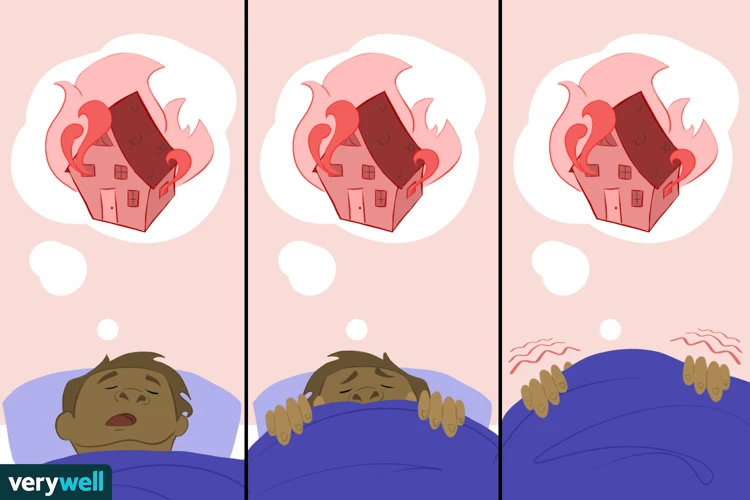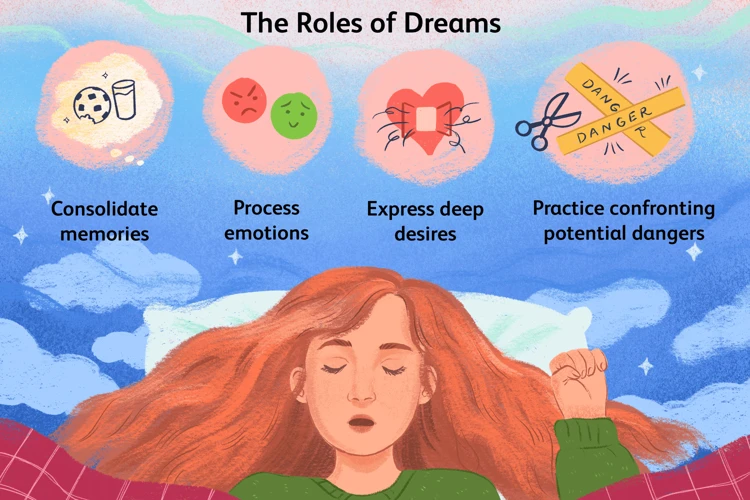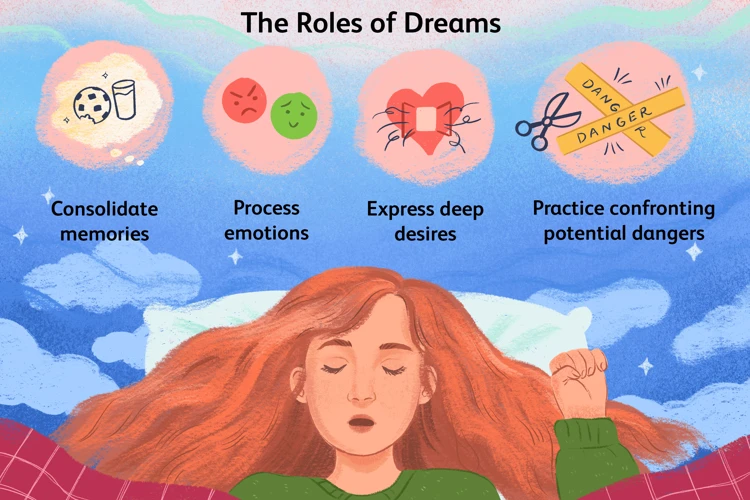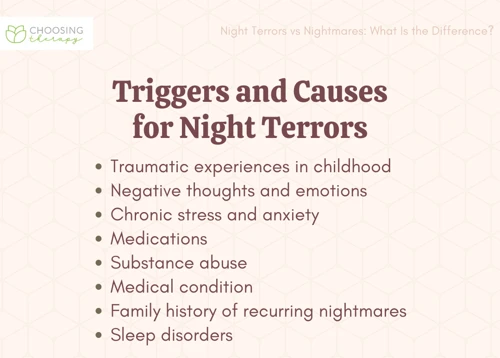Exploring the Link Between Nightmares and Trauma Recovery – A Guide to Understanding
For individuals who have experienced trauma, nightmares can be a distressing and all too familiar occurrence. These vivid and often terrifying dreams can disrupt sleep, leaving survivors feeling anxious, scared, and overwhelmed. However, a closer examination reveals that nightmares serve a deeper purpose in the journey of trauma recovery. In this comprehensive guide, we will delve into the relationship between nightmares and trauma recovery, uncovering the ways in which these dreams manifest, how they impact the healing process, and strategies for managing and utilizing them effectively. By understanding the role nightmares play in trauma recovery, survivors can gain valuable insights, promote emotional catharsis, and ultimately move closer to a place of healing and growth.
What Are Nightmares?

Nightmares are intense, vivid, and often disturbing dreams that can leave a lasting impact on our emotions and well-being. They typically occur during the rapid eye movement (REM) stage of sleep, which is when we experience the most vivid dreams. Unlike regular dreams, nightmares are characterized by feelings of fear, terror, and anxiety, and they often involve disturbing or traumatic scenarios. These dreams can be accompanied by physical sensations such as sweating, increased heart rate, and an overwhelming sense of dread. Nightmares are a natural part of our dream cycle and can be triggered by a variety of factors, including stress, anxiety, and trauma. While they can be distressing, nightmares also serve as a way for our subconscious mind to process and make sense of the events and emotions we experience during our waking hours. By delving into the symbolism and messages within nightmares, individuals can gain valuable insights into their psyche and potentially uncover unresolved issues that require attention and healing. For trauma survivors, nightmares can be particularly common, as they may reflect the deep-seated trauma and anxieties that need to be addressed and resolved. Understanding the nature of nightmares and their significance is essential in trauma recovery, as it allows individuals to harness the healing potential of dreams and work towards achieving mental well-being and personal growth.
How Trauma Impacts Dreams

When it comes to trauma, its impact extends beyond our waking hours, affecting the realm of dreams as well. Trauma can significantly influence the content and frequency of our dreams, shaping them into vivid and distressing experiences. Nightmares, specifically trauma-related nightmares, serve as manifestations of the deep psychological scars left by traumatic events. These nightmares often contain recurrent themes that reflect the unresolved trauma and anxieties that survivors carry. These themes can vary from re-enactments of the traumatic event to symbolic representations of the emotional turmoil experienced. Understanding the impact of trauma on dreams is crucial in the healing process as it allows individuals to recognize and explore their subconscious fears, ultimately leading to the potential for healing, growth, and self-exploration. By delving into the connection between trauma and dreams, individuals can harness the healing potential of dreams in their recovery journey. The next section will delve further into the reasons why nightmares occur during trauma recovery and how they contribute to the healing process.
Nightmares as Manifestations of Trauma
Nightmares can often serve as manifestations of trauma, playing out the intense emotions and memories associated with the traumatic event within the realm of dreams. When a person experiences trauma, the mind can struggle to process and make sense of the overwhelming emotions and sensations that accompany it. This can lead to the intrusion of these unresolved experiences into the dream state. Nightmares related to trauma often involve vivid reenactments of the traumatic event itself, with the individual reliving the fear, helplessness, and distress that they experienced during the actual event. These nightmares may occur immediately after the trauma or resurface at later stages of the recovery process. They can be incredibly distressing and may disrupt sleep, leaving the individual feeling anxious and on edge. However, it is important to remember that nightmares are not a sign of weakness or regression; rather, they are an indication that the mind is actively attempting to process and integrate the traumatic experience. By exploring the symbolism and emotions present in these nightmares, individuals can gain valuable insights into the impact of the trauma on their psyche and take steps towards healing and recovery. It is crucial to approach these nightmares with compassion and seek therapeutic support to navigate through the complexities of trauma and its manifestations within the dream world. Understanding the connection between nightmares and trauma can provide a starting point for utilizing the healing potential of dreams in the recovery journey. (source: healing potential of dreams in trauma recovery)
Recurrent Themes in Trauma-Related Nightmares
Recurrent themes in trauma-related nightmares provide a glimpse into the profound impact that trauma has on the subconscious mind. While the specific content of nightmares can vary greatly from person to person, there are certain themes that tend to reoccur in individuals who have experienced trauma. These themes often reflect the core aspects of the traumatic event and the emotions associated with it. Common recurrent nightmares include reliving the traumatic event, being trapped or unable to escape, experiencing intense fear or helplessness, encountering threatening figures or monsters, and feeling overwhelmed by a sense of danger or impending doom. These themes in trauma-related nightmares serve as symbolic representations of the deep-rooted fears, anxieties, and unresolved emotions that survivors may carry. It is important to note that the interpretation of these nightmares may vary, as they are highly subjective and influenced by personal experiences and memories. Additionally, these recurrent themes may evolve and change over time as the healing process progresses. Exploring these themes with the help of a therapist or through personal reflection can provide valuable insights into the impact of trauma and serve as a catalyst for mental well-being and personal growth. By understanding and addressing the recurrent themes in trauma-related nightmares, individuals can begin to confront and heal from their traumatic experiences, ultimately paving the way for a brighter and more fulfilling future.
Why Do Nightmares Occur During Trauma Recovery?

During trauma recovery, nightmares often occur as a result of the complex healing process taking place within the mind and body. These distressing dreams can serve multiple purposes in the journey towards healing. Firstly, nightmares allow for the processing and integration of traumatic experiences, as the subconscious mind attempts to make sense of the trauma and find resolution. Nightmares provide an avenue for the release of suppressed emotions, allowing individuals to express and confront their fears in a safe dream environment where they can be explored and processed. Nightmares often serve as symbolic representations of the healing journey, with recurring themes and symbols reflecting the progress being made in overcoming trauma. By understanding why nightmares occur during trauma recovery, individuals can better navigate and harness the transformative power of their dreams. Recognizing the significance of nightmares in the journey towards mental well-being and personal growth is a crucial step in utilizing dreams as valuable tools for healing.
Processing and Integration of Traumatic Experiences
Processing and integrating traumatic experiences is a critical aspect of trauma recovery. Nightmares play an essential role in this process, as they provide a platform for the subconscious mind to revisit and make sense of the traumatic events. When we experience trauma, our minds often struggle to process the overwhelming emotions and memories associated with the event. These unresolved emotions and memories can manifest in nightmares, allowing the brain to process, normalize, and integrate the traumatic experiences. The vivid and sometimes distressing imagery in nightmares helps to recreate the emotions and sensations associated with the trauma, initiating a natural healing process. Through the dreamscape, the mind attempts to make sense of the trauma and find ways to cope with the residual emotions. Nightmares provide a safe environment for the mind to revisit and reconstruct traumatic events, allowing for a gradual desensitization and transformation of the traumatic memories into more manageable fragments. This processing and integration of traumatic experiences through nightmares contribute significantly to the overall healing and recovery process. By exploring the underlying messages and symbolism in nightmares, individuals can gain a deeper understanding of their trauma, engage in introspection, and progress towards achieving mental well-being and personal growth. Recognizing the significance of nightmares as a tool for processing and integrating traumatic experiences is crucial in the journey towards healing and resilience.
Release of Suppressed Emotions
Nightmares play a crucial role in trauma recovery by providing an avenue for the release of suppressed emotions. When individuals experience trauma, it is common for them to push down and repress their feelings as a coping mechanism. However, these emotions often continue to linger beneath the surface, impacting their mental well-being. Nightmares can serve as a powerful outlet for these suppressed emotions, allowing individuals to confront and process their trauma in a safe and controlled environment. Through the symbolic and often intense nature of nightmares, individuals may find themselves experiencing the full range of emotions associated with the traumatic event. This release of suppressed emotions can be cathartic and healing, as it provides an opportunity for individuals to acknowledge and validate their feelings. The process of experiencing these emotions within the context of a nightmare can be transformative, allowing individuals to gain a deeper understanding of themselves and their trauma. By embracing and working through these emotions, individuals can begin to move towards personal growth and find a sense of empowerment and healing. To read more about the significance of dreams in mental well-being, click here.
Symbolic Representation of the Healing Journey
Symbolic representation in nightmares can play a significant role in the healing journey of trauma recovery. As traumatic experiences leave deep imprints on our psyche, nightmares often serve as metaphoric and symbolic expressions of the healing process. These dreams may contain elements and imagery that reflect the intensity of the trauma and the emotions associated with it. For example, a survivor of a car accident may have recurring nightmares about being trapped in a vehicle, representing their feelings of helplessness and fear during the event. These symbolic representations allow the subconscious mind to process and integrate the traumatic experience, gradually working towards resolution and healing. By recognizing and understanding the symbolism within nightmares, individuals can gain valuable insights into their own thoughts, feelings, and beliefs surrounding the trauma. The symbolism acts as a doorway to self-exploration and personal growth, providing opportunities for individuals to confront and work through unresolved issues. Through the exploration of these symbols, individuals can embark on a transformative journey towards healing, resilience, and a restored sense of self. [Link: Dreams, Self-Exploration, and Personal Growth](/dreams-self-exploration-personal-growth/)
The Role of Nightmares in Trauma Recovery

Nightmares play a crucial role in the process of trauma recovery, serving as powerful indicators and catalysts for healing. While nightmares can be distressing, they provide valuable clues and insights into the underlying trauma and its impact on an individual’s psyche. These dreams often contain symbolic representations of unresolved emotions, memories, and fears, allowing survivors to confront and process these experiences in a safe, controlled environment. By exploring and analyzing the themes, images, and emotions within nightmares, individuals can gain a deeper understanding of their trauma and work towards healing and resolution. Nightmares also promote emotional catharsis, allowing survivors to release suppressed emotions and confront their fears head-on. This release of pent-up emotions can provide a sense of relief and liberation, enabling individuals to progress in their trauma recovery journey. As trauma survivors begin to heal, nightmares can indicate progress and healing, gradually evolving into less frequent and intense dreams. By embracing and utilizing the role of nightmares in trauma recovery, individuals can harness their transformative power, leading to personal growth and a stronger sense of resilience and well-being.
Providing Clues and Insights
Nightmares play a significant role in trauma recovery by providing valuable clues and insights into the underlying issues that need to be addressed. When individuals have experienced trauma, their subconscious mind often holds onto unprocessed emotions, memories, and fears. Nightmares serve as a channel through which these suppressed experiences and emotions can find expression. The vivid and often symbolic nature of nightmares allows them to act as a mirror, reflecting the unprocessed aspects of the trauma survivor’s psyche. By analyzing the themes, symbols, and emotions present in the nightmares, individuals and their therapists can gain a deeper understanding of the unresolved trauma and its impact on their mental and emotional well-being. For example, recurring themes of vulnerability, powerlessness, or danger in nightmares may indicate unresolved trauma related to a specific event or period in the survivor’s life. Similarly, symbols or specific scenarios in nightmares can serve as metaphors for the emotions and challenges the survivor is facing. Through journaling, therapy sessions, or discussions with a trusted support system, survivors can explore these clues and gain insights into their trauma, allowing them to develop coping strategies, process emotions, and take steps towards healing and recovery. The process of decoding and understanding these clues and insights can be a transformative and empowering journey for trauma survivors, enabling them to reclaim their power, find healing, and build resilience in the face of adversity.
Promoting Emotional Catharsis
Promoting emotional catharsis is one of the key roles that nightmares play in the process of trauma recovery. Nightmares provide a unique platform for individuals to release pent-up emotions and process unresolved feelings related to their traumatic experiences. When a survivor experiences a nightmare, the vividness and intensity of the dream can evoke strong emotional responses. This can allow them to tap into the emotions that may have been suppressed or repressed, providing an opportunity to confront and express them in a safe and controlled environment.
One way nightmares promote emotional catharsis is by bringing buried emotions to the surface. The distressing and often frightening content of nightmares can replicate the intense emotions associated with the original trauma. As the individual dives into the emotions experienced during the nightmare, they can begin to recognize and acknowledge the pain, fear, and sadness that they have been carrying. This process of emotional release can be cathartic, enabling survivors to process and let go of the emotional burden they have been carrying.
Nightmares also offer an avenue for exploring and working through unresolved issues. The symbolism and narrative presented during a nightmare can reflect the underlying emotions and unresolved aspects of the trauma. By analyzing the content of the nightmares, individuals can gain insight into their subconscious mind and identify areas of their trauma that still require attention and healing. This awareness allows survivors to engage in therapeutic interventions that address these unresolved issues, such as counseling, trauma-focused therapies, and self-care practices.
Discussing nightmares with a therapist or support group can provide a space for survivors to openly express their emotions without judgment or fear. Sharing the details of their nightmares enables survivors to verbalize their experiences and connect with others who may have similar dreams or experiences. This validation and empathy can further contribute to emotional catharsis and help individuals feel heard, understood, and validated in their healing journey.
Nightmares play a crucial role in promoting emotional catharsis for trauma survivors. By bringing buried emotions to the surface, allowing for exploration and resolution of unresolved issues, and providing a platform for open expression and validation, nightmares can facilitate the release of pent-up emotions and contribute to the overall healing process.
Indicating Progress and Healing
Nightmares can also serve as indicators of progress and healing in the journey of trauma recovery. As survivors work through their trauma and engage in therapeutic interventions, the content and intensity of their nightmares may begin to change. Initially, nightmares may be more frequent and intense, reflecting the unresolved emotions and trauma that need to be processed. However, over time and with the appropriate support, nightmares may start to decrease in frequency and intensity.
One way in which nightmares indicate progress is through the transformation of their content. As survivors heal and confront their trauma, the themes and scenarios portrayed in their nightmares may evolve. For example, a survivor who initially experienced nightmares depicting scenes of helplessness and victimization may begin to have dreams where they are empowered and assertive. These changes indicate the gradual integration of the trauma into their narrative, signaling a shift towards healing and growth.
The emotions experienced during nightmares can also be revealing. As survivors process their trauma, they may find that the overwhelming fear and anxiety associated with nightmares start to dissipate. Instead, they may begin to feel a sense of resilience, strength, and even resolution within their dreams. This shift in emotional intensity can signify the progress that has been made in healing and overcoming the trauma.
It is important to note that progress in trauma recovery is not linear, and setbacks or the return of intense nightmares are common. However, consistently observing a reduction in nightmare frequency and intensity over time can provide reassurance and validation that healing and progress are occurring. It can serve as a source of motivation and encouragement for survivors to continue their journey towards recovery.
Nightmares can act as indicators of progress and healing during trauma recovery. The transformation of nightmare content and the shift in emotional intensity within these dreams signify the integration and resolution of trauma. While setbacks are expected, consistently observing a reduction in nightmare frequency and intensity can provide survivors with hope and motivation to persist in their healing journey. By acknowledging and interpreting the messages within nightmares, individuals can gain a deeper understanding of their progress and continue their path towards growth and recovery.
Managing Nightmares for Trauma Survivors
Nightmares can significantly impact the well-being of trauma survivors, but there are effective strategies for managing and minimizing their frequency. Creating a safe sleeping environment is crucial, ensuring a calm and comforting atmosphere that promotes relaxation and a sense of security. This can involve minimizing external stimuli, such as noise or light, and establishing a consistent bedtime routine. Engaging in relaxation techniques, such as deep breathing exercises or meditation, before sleep can help reduce anxiety and promote a more peaceful slumber. Therapeutic interventions, such as cognitive-behavioral therapy (CBT) or eye movement desensitization and reprocessing (EMDR), can be immensely helpful in addressing the root causes of nightmares and providing effective coping mechanisms. Additionally, exploring imagery rehearsal therapy, a technique that involves rewriting nightmares with more positive or empowering outcomes, can redefine the narrative and diminish the impact of traumatic dreams. By implementing these strategies, trauma survivors can better manage their nightmares and take significant steps towards healing and recovery.
Create a Safe Sleeping Environment
Creating a safe sleeping environment is crucial for trauma survivors who experience nightmares. Here are some steps to implement in order to promote a sense of safety and security during sleep:
- Establish a Calming Bedtime Routine: Develop a consistent bedtime routine that helps signal to your body and mind that it is time to relax and prepare for sleep. This routine can include activities such as taking a warm bath, practicing deep breathing exercises, or engaging in gentle stretching.
- Eliminate Potential Triggers: Make your bedroom a sanctuary by removing any items or stimuli that may trigger anxiety or distress. This may include keeping the room clutter-free, removing electronics, and creating a calming ambiance with soft lighting and soothing sounds.
- Use Safety Objects: Sleeping with a stuffed animal or a weighted blanket can provide a sense of comfort and security that can help ease anxiety and promote a better night’s sleep.
In addition to these steps, it is important to cultivate a sense of emotional safety within your sleeping environment. This can be achieved by:
- Cultivating a Supportive Bedtime Environment: Surround yourself with positive and supportive elements. This may include playing calming music, using aromatherapy with relaxing scents like lavender, or having a trusted loved one nearby.
- Establishing Boundaries: Set clear boundaries with others who share your living space to ensure privacy and uninterrupted sleep. This can involve discussing expectations around noise levels, respecting sleep schedules, and creating a space that is solely dedicated to rest and relaxation.
- Seeking Professional Help: If nightmares persist and significantly impact your quality of sleep and daily life, it may be beneficial to seek the support of a mental health professional who specializes in trauma and sleep disorders. They can offer guidance and therapeutic interventions to help manage and reduce the frequency and intensity of nightmares.
By creating a safe and nurturing sleeping environment, trauma survivors can enhance their ability to relax, experience better sleep quality, and minimize the occurrence of distressing nightmares.
Practice Relaxation Techniques
When dealing with nightmares during trauma recovery, practicing relaxation techniques can be incredibly helpful in reducing stress, anxiety, and promoting a sense of calmness before sleep. Here are some relaxation techniques that trauma survivors can incorporate into their nighttime routine:
- Deep Breathing: Deep breathing exercises, such as diaphragmatic breathing, can help calm the body and mind. Take slow, deep breaths in through the nose, hold briefly, and exhale slowly through the mouth. Repeat this rhythmic breathing pattern several times, focusing on the sensation of the breath.
- Progressive Muscle Relaxation: This technique involves systematically tensing and relaxing each muscle group in the body. Starting from the toes and working your way up to the head, tense each muscle group for a few seconds, then release the tension while focusing on the feeling of relaxation.
- Meditation: Engaging in mindfulness meditation before sleep can promote relaxation and reduce anxiety. Find a quiet and comfortable space, close your eyes, and focus your attention on your breath or a specific object. As thoughts arise, gently acknowledge them and let them pass without judgment.
- Guided Imagery: This technique involves visualizing calming, peaceful images or scenes. You can listen to pre-recorded guided imagery sessions, or simply create your own mental images of a serene setting, such as a calming beach or a tranquil garden.
- Aromatherapy: Using calming scents, such as lavender or chamomile, can help create a relaxing atmosphere before sleep. Consider using essential oils in a diffuser, applying them to your pillow or bedding, or taking a soothing bath with scented bath oils or salts.
By incorporating these relaxation techniques into a nightly routine, trauma survivors can create a conducive environment for a restful sleep and minimize the occurrence of nightmares. It is important to find the technique or combination of techniques that work best for each individual and to practice them consistently for optimal results. Practicing relaxation techniques not only helps manage nightmares but also promotes overall well-being and enhances the healing process during trauma recovery.
Engage in Therapeutic Interventions
Engaging in therapeutic interventions is an essential step in managing nightmares and supporting trauma recovery. Therapeutic interventions can provide individuals with the necessary tools, support, and guidance to navigate the challenges presented by nightmares. One effective intervention is trauma-focused therapy, such as Cognitive Behavioral Therapy (CBT). CBT aims to identify and challenge negative thought patterns and beliefs that contribute to nightmares. Additionally, Eye Movement Desensitization and Reprocessing (EMDR) therapy can help process and reframe traumatic memories that fuel nightmares. This therapy involves bilateral stimulation, such as eye movements or taps, while focusing on distressing memories. Another therapeutic intervention that can be beneficial is imaginal exposure therapy. Here, individuals recount their nightmares in a safe and controlled environment, allowing them to gradually desensitize and gain mastery over their fears. Additionally, relaxation techniques such as deep breathing exercises, progressive muscle relaxation, and mindfulness meditation can help reduce anxiety and promote a peaceful sleep environment. Seeking support groups, such as trauma-focused groups or dream analysis groups, can also provide a sense of community and validation for individuals experiencing nightmares. By engaging in therapeutic interventions, individuals can address the underlying causes of nightmares, develop coping mechanisms, and ultimately foster healing and recovery.
Explore Imagery Rehearsal Therapy
Imagery Rehearsal Therapy (IRT) is a therapeutic intervention that can be highly effective in managing and reducing the frequency and intensity of nightmares for trauma survivors. This evidence-based therapy involves revisiting and reimagining the content of the nightmares in a safe and controlled environment. By actively engaging with the dream imagery during waking hours, individuals can gain a sense of empowerment and control over their nightmares. The process typically involves discussing the nightmare with a trained therapist or counselor, identifying any distressing aspects, and then collaboratively working to modify and rehearse a new, positive ending or resolution to the dream. Through repeated mental rehearsals, individuals gradually become desensitized to the original distressing elements of the nightmare and develop a sense of mastery and confidence in their ability to manage and overcome the dream’s impact. Imagery Rehearsal Therapy not only helps to alleviate the distress caused by nightmares but also provides an opportunity for trauma survivors to confront and overcome the underlying themes and fears that may be associated with their trauma. In addition to working with a therapist, individuals may also be encouraged to practice imagery rehearsal techniques on their own, allowing them to continue the healing process outside of therapy sessions. IRT has shown promising results in reducing nightmare frequency, improving sleep quality, and promoting overall psychological well-being. If you’re interested in exploring imagery rehearsal therapy for managing nightmares as part of your trauma recovery, it is recommended to seek guidance from a trained mental health professional who specializes in this therapeutic approach.
Conclusion
In conclusion, the relationship between nightmares and trauma recovery is a complex and intriguing one. Nightmares, as intense and distressing as they may be, serve a purpose in the healing process. They can be manifestations of trauma, recurring themes that highlight unresolved issues, and symbolic representations of the journey towards healing. By understanding the role of nightmares in trauma recovery, individuals can gain valuable insights, release suppressed emotions, and track their progress and healing. Managing nightmares is crucial for trauma survivors, and creating a safe sleeping environment, practicing relaxation techniques, engaging in therapeutic interventions, and exploring techniques such as imagery rehearsal therapy can be beneficial. It is important to remember that the process of trauma recovery is unique to each individual, and the significance and interpretation of nightmares may vary. Through self-exploration, support, and resilience, trauma survivors can harness the healing potential of nightmares and work towards reclaiming their mental well-being and personal growth. Nightmares may be unsettling, but they can also be powerful tools for healing and transformation.
Frequently Asked Questions
1. What causes nightmares?
Nightmares can be caused by a variety of factors, including stress, anxiety, trauma, certain medications, and sleep disorders such as sleep apnea.
2. Are nightmares a sign of mental illness?
While nightmares can be a symptom of some mental health conditions, such as post-traumatic stress disorder (PTSD), they are not necessarily indicative of a mental illness on their own.
3. Can nightmares be related to past trauma?
Absolutely. Nightmares are often a manifestation of unresolved trauma and can serve as a way for the subconscious mind to process and integrate traumatic experiences.
4. How can nightmares impact trauma recovery?
Nightmares can be both distressing and informative during trauma recovery. They may provide clues and insights into unresolved issues, promote emotional catharsis, and indicate progress and healing.
5. Can recurring nightmares be a sign of trauma-related disorders?
Recurring nightmares, especially those with similar themes related to the traumatic event, can be a symptom of trauma-related disorders like PTSD or acute stress disorder.
6. Are there any benefits to nightmares?
Despite their negative nature, nightmares can have benefits. They can serve as a warning sign, bring unresolved issues to the forefront, and offer an opportunity for emotional release and growth.
7. How can someone manage and cope with nightmares?
Managing nightmares involves creating a safe sleeping environment, practicing relaxation techniques before bed, engaging in therapeutic interventions, and exploring imagery rehearsal therapy.
8. Can medication help with recurring nightmares?
Medication can be prescribed in some cases to manage nightmares, particularly if they are interfering with sleep and overall well-being. However, a comprehensive approach that combines therapy and other coping strategies is often recommended.
9. Should someone seek professional help for frequent nightmares?
If frequent nightmares are significantly impacting your daily life, disrupting sleep, or causing distress, it may be beneficial to seek professional help from a therapist or healthcare provider who specializes in trauma and sleep disorders.
10. Can lucid dreaming be used to control nightmares?
Lucid dreaming, a state where you become aware that you are dreaming, can potentially be used to control and alter nightmares. With practice and proper techniques, individuals may be able to change the course of their dreams and transform nightmares into more positive experiences.








